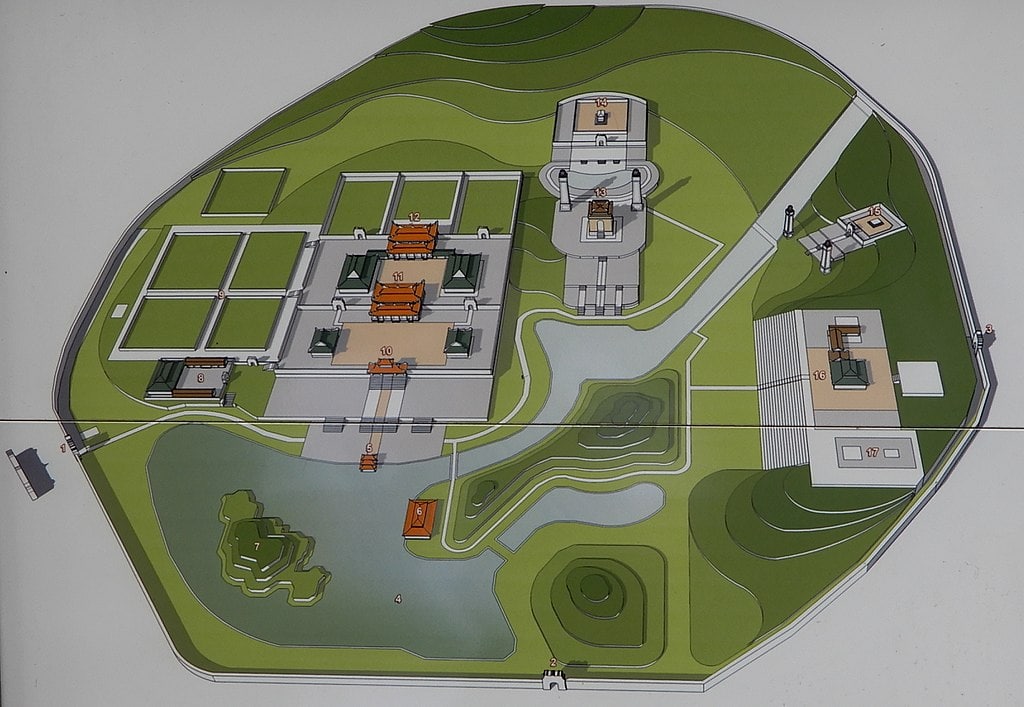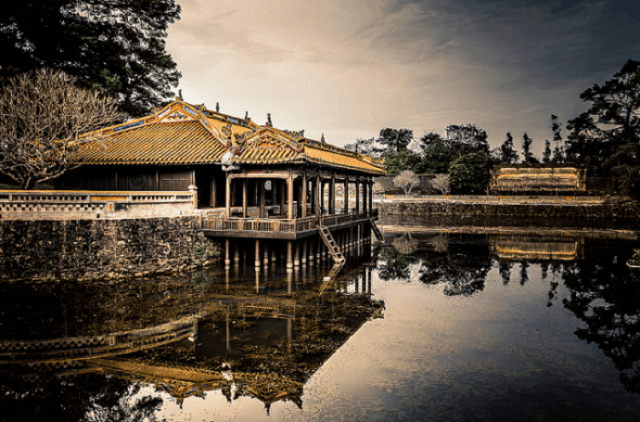TOMB OF TU DUC – TOMB OF MODESTY
TOMB OF TU DUC – TOMB OF MODESTY
he tomb of Tu Duc Emperor (also known as Khiêm Lăng) is one of the numerous appealing mausoleums on the outskirts of Hue imperial city. It sits in a wonderful pine valley of Duong Xuan Thuong Village (Thuong Ba Hamlet, Thuy Xuan Commune), away about 8 km from Hue city.
Covering the area of 20 hectares, the mausoleum accommodates 50 structures surrounded by a 1,500 m long wall, building from 1864 – 1867.
Table Of Contents [hide]
1. History of Tu Duc Tomb Hue Viet Nam.
Tu Duc was the fourth emperor of the Nguyen dynasty and he was on the throne over 35 years, the longest one compared to other rulers’.
Although he was expertise in philosophy, oriental history, and literature, he did not succeed in ruling the country. Especially in the period of Vietnam encountering western developing capitalism.
Having no son to weary, he ordered the construction of his tomb, creating a fairyland. Not only was it a world for his everlasting life after death, but it was also his lifetime recreation ground, where he could compose poets, hunt little animals, or even comfort himself with his concubines.
However, as the end of the construction, the emperor seemed to be inspired by humility. He added the word “Khiem” (“modesty”) to all the names of constructions in his complex.
2. Tu Duc Tomb Map

3. View Tu Duc Tomb palace 360 looked from outside
4. What to see at The mausoleum of Tu Duc Emperor?
4.1. Luu Khiem lake
When entering the compound, you will first walk to the north nearly 400 feet down a sidewalk made out of the finest ceramic tiles from Bat Trang village. Then you will see the lake on the right. There are two structures on the nearshore of the lake, namely Du Khiem boat landing and Xung Khiem pavilion.
Du Khiem’s boat landing was designed for the emperor to disembark after his hunting trips to Tinh Khiem island in the middle of Luu Khiem lake.
From Du Khiem boat landing, you walk to the north about 100 feet, then take a left turning and walk 100 feet due east to reach the pavilion. It is a pavilion where the emperor could sit at his leisure with his concubines, write verses and read their compositions.
4.2. Hoa Khiem palace
Khiem Cung gate, opposite Du Khiem boat landing, leads into the courtyard in front of Hoa Khiem Palace, the emperor’s residence when he was visiting. After his death, the palace was switched to a temple where the emperor’s memory was worshipped.
There are a lot of ancient stuff of the emperor in the tomb, such as the Western clock from the French government and two thrones. One interesting fact is that Tu Duc was considerably smaller than his empress, so he used to occupy the smaller one.
4.3. Luong Khiem temple
The temple located directly behind Hoa Khiem palace was a center of worship for the departed soul of Tu Du, the emperor’s mother.
4.4. Minh Khiem chamber
It is standing behind and to the right of Hoa Khiem Palace, which is the second Royal Theater for the emperor and his retinue to entertain.
You may have a chance to dress up as the emperor (and his empress) and pose for fascinating souvenir pictures. Moreover, the staff is also closeby and ready to pose as mandarins in the pictures.
5. Structure of Tu Duc Tomb
5.1. The Royal Courtyard
Following the brick path outside the Khiem Cung gate, you may proceed about 500 feet to the northwest till you reach the forecourt in front of the stele pavilion.
On the Royal Courtyard, there are 2 rows of sculptures of horses, elephants, and mandarins. Because of the Emperor’s constitution so the mandarins statues could not be taller than him. They are there on the Courtyard, waiting for the emperor to do business in the after-life.
5.2. Stele Pavilion at Tu Duc Royal Tomb
Walking between such this honor guard, you’ll reach the first building in the necropolis, a stele pavilion. This accommodates a 22-ton stone stele, the largest one in Vietnam. It inscribes the emperor’s biography and his fault to the Royal family and the country.
Plus, two pillars flank the stele pavilion – these obelisks are other common sights in royal tombs, as they represent the emperor’s power.
5.3. The emperor’s sepulcher
Walking 200 feet to the west, you’ll reach the final point in the necropolis. The Buu Thanh brick wall that encircles the emperor’s sepulcher. The tomb, almost alone among this imperial tomb’s structures, designed in a simple and modest style.
Actually, the emperor is not buried under this tomb. Instead, when Tu Duc passed away, he was buried secretly somewhere in Hue. So the location of the emperor’s coffin is still a mystery until now.
As you know, Kien Phuc, Tu Duc’s adoptive son grave is also in Tu Duc’s tomb complex as well. His grave occupying a small site about 500 feet to the north of the Xung Khiem pavilion. Plus Tu Duc’s empress is also buried across the lake, 500 feet to the west of Kien Phuc’s tomb.
6. Tu Duc Tomb Hue Vietnam photos
7. Things to know before visiting Tu Duc Tomb
7.1. Tu Duc Tomb Hue – Viet Nam Entrance fee
As you expected, the tomb is open from 7 a.m. to 5 p.m every day. In 2019, the entrance ticket costs VND 100,000 (roughly USD 5) for adults and VND 30,000 (nearly USD 1.30) for kids. In 2020, the entrance fee will increase up VND 150,000 (roughly USD 6.5) for adults. It costs VND 40,000 (roughly USD 2) for kids under 12-year-old.
7.2. How to get to Tu Duc Royal Tomb Hue?
There are many ways to get to the Tomb of Tu Duc Emperor, including booking a grab bike, catching a cyclo, taking a boat trip or walking. Another fantastic way to hugely enjoy the site is to book a private city tour Tu Duc via Culture Pham Travel.
Besides, remember to wear sunglasses, hats, and sunscreen as well as bring water bottles in the dry season. Prepare raincoats or bring umbrellas in the wet season for full enjoyment.
You can get more information about beautiful landscapes and Unesco monuments in Hue such as Thien Mu Pagoda, Hue Imperial City… at our website.







Comments
Post a Comment